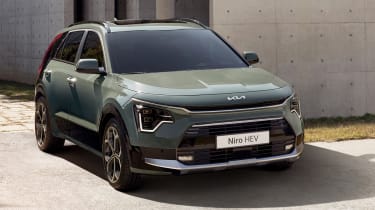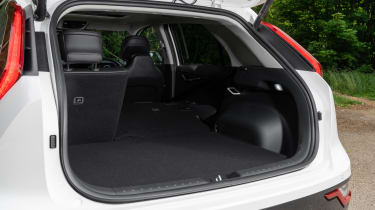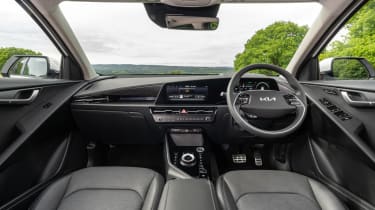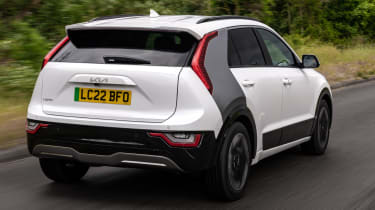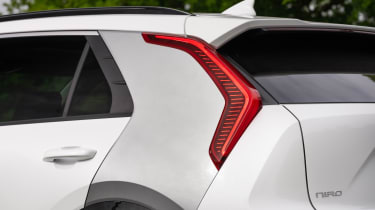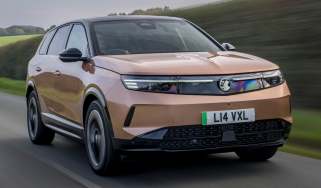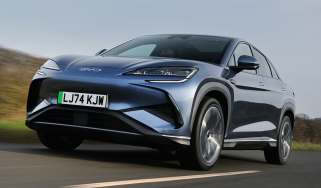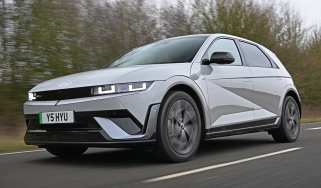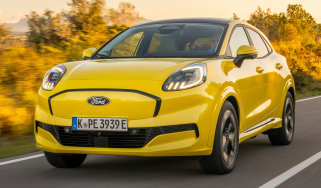2022 Kia Niro: prices, specs and Niro EV prototype drive
Kia’s smaller family SUV starts from under £30k, with Niro EV models starting from £34,995
- Second-generation Niro features a striking new design
- Three levels of engine electrification
- Available to pre-order now
The all-new Kia Niro is now available to pre-order from £27,745. This revised version of Kia’s compact family SUV offers three levels of engine electrification – ‘self-charging’ hybrid, plug-in hybrid and fully electric – along with cutting-edge technology and a clean-sheet design.
The first customer deliveries are expected to begin in early Autumn. The new Niro will re-enter a fiercely competitive segment, rivalling popular family SUVs like the Ford Kuga and Nissan Qashqai, as well as fully electric SUVs such as the Skoda Enyaq iV and MG ZS EV.
 Top 10 best hybrid SUVs in 2025
Top 10 best hybrid SUVs in 2025
We’ve now tried out a prototype of the new Kia Niro EV on UK roads, and you can read our thoughts on it lower down. The Niro EV is expected to account for around half of Niro sales, but it needs to improve to keep pace with a growing number of alternatives.
2022 Kia Niro Hybrid SUV: pricing and specs
Kicking off the revised Kia Niro range is the ‘2’ trim, which starts from £27,745 as a hybrid and £32,775 in plug-in hybrid form. Despite its ‘entry-level’ status, this car comes with a long list of standard equipment including 16-inch alloy wheels, LED headlamps, a reversing camera, adaptive cruise control and an eight-inch touchscreen with DAB radio, Apple CarPlay and Android Auto.
The mid-level Kia Niro ‘3’ will likely be the most popular choice in the range. In addition to the features found in ‘2’ trim, ‘3’ cars benefit from larger 18-inch alloy wheels, seats partly upholstered in artificial leather, heated front seats, a heated steering wheel, reclining rear seats, a wireless phone charger and a more advanced 10-inch central touchscreen with built-in sat-nav. This starts from £30,495 for the hybrid and £35,525 when specified in plug-in hybrid guise.
Topping off the Kia Niro Hybrid range is the ‘4’ trim, which will set buyers back £33,245 and £38,775 for the hybrid and plug-in hybrid respectively. Kia seeks to justify this model’s higher price with plenty of luxurious features such as a 10.25-inch digital instrument cluster, supplemented by a projected head up display. These cars also get full artificial leather upholstery, heated and ventilated front seats with memory function, as well as heated rear seats, an automated tailgate and an opening panoramic sunroof. In addition, Kia Niro ‘4’ models can also be configured with a unique contrasting C-pillar design in either grey or black.
2022 Kia Niro EV SUV: pricing and specs
Meanwhile, the new Kia Niro EV starts from £34,995. Just like the hybrid models, the electric variant of the Niro is available in three distinct trim levels, and the kit list for each is similar to the hybrids. All Niro EV models feature an 11kW on board charger and can be charged from 10-80% in as little as 45 minutes when plugged into a compatible public fast-charger.
Kia Niro EVs in ‘3’ trim also benefit from V2L (Vehicle-to-Load) capability which enables you to use your EV as a power source for plugging in electrical items. A heat pump is available for an additional cost to provide greater efficiency.
Finally the Kia Niro ‘4’ trim sits at the pinnacle of the range and starts from £40,495. This gets artificial leather upholstery with heated and ventilated front seats, plus heated rear seats, a Harmon/Kardon sound system and an automated tailgate. Cars specified in ‘4’ trim also get enhanced safety and driver assistance systems with forward-collision-avoidance and semi-autonomous motorway driving capability. Just like on the hybrids, Niro ‘4’ models can be specified with a bi-tone C-Pillar.
Design, dimensions and practicality
The exterior of the new Niro has been given a complete redesign with a much bolder look than before. The nose features Kia’s signature ‘tiger face’ grille design, headlights mounted lower than before complete with an angular LED daytime running light design, and a large lower air intake. It also features a sculpted ‘clamshell’ style bonnet with a raised centre section.
Buyers will be able to personalise the new Niro in a choice of nine exterior colours, including the distinctive Cityscape Green shade seen here. Those opting for a car in top-spec ‘4’ trim can also choose from two bi-tone C-pillar finishes as well as optional Steel Grey body cladding.
The new car is also larger than the outgoing model, measuring in at 65mm longer, 20mm taller and 10mm wider. It also features a 20mm-longer wheelbase (the distance between the front and rear wheels), which now measures 2,720mm. As a result of the increased dimensions, the brand says the new Niro is more spacious than before. Boot space has also been improved, increasing to 451 litres in the hybrid model, an improvement of 15 litres over the old car. A 20-litre front stowage area will be available on the fully electric variant, bringing the total storage space to 495 litres.
Interior and technology
The dashboard shares plenty of design cues with the EV6, although it doesn’t feel as spacious inside. There’s a similar two-spoke steering wheel and dashboard design. The centrepiece is the dual-screen set-up, which merges the digital dial cluster and central infotainment into a single housing to give the appearance of a single ultrawide screen. In higher-spec models, this set-up will comprise a pair of 10.25-inch screens, which will feature sharper graphics designed to make the system more user-friendly.
Beneath this is a touch-sensitive control panel featuring a pair of rotary dials, together with a circular gear selector, an adjustable cupholder and a smartphone charging pad. The Niro EV will also feature a KIA Connect system that shows charge status and enables route planning to consider potential charge stations along the way. There are diagonal air vents in the upper section of the dash, along with ambient interior mood lighting capable of displaying up to 74 colour combinations.
The interior uses an array of recycled materials, including headlining made from recycled wallpaper, faux leather seat upholstery derived from eucalyptus leaves and a water-based paint finish on the door panels, with a choice of seven upholstery finishes. Elsewhere, the front seats feature a new lightweight mechanism making them slimmer than the current car’s, which helps improve interior space, but they also now include USB sockets and rear-mounted coat hangers. Kia has also incorporated what they call a ‘special relaxation’ setting into the front passenger seat, which can fully recline it into a lying posture at the touch of a button.
Engines and electric motors
Continuing on from the last Niro, the new car is available with three different electrified powertrains: hybrid, plug-in hybrid or full electric. Both the hybrid and the plug-in hybrid will feature Kia’s 1.6-litre petrol engine producing 104bhp. This figure is increased to an overall 139bhp for the hybrid and 180bhp for the plug-in hybrid because of the size of the electric motor. The entry level variant will be assisted by a smaller battery pack used to optimise efficiency and power. The plug-in variant will be quicker, with more assistance from its larger battery, and be able to cover up to 40 miles of range on a single charge.
A six-speed dual-clutch automatic gearbox is standard, along with front-wheel drive. Kia’s smart-regenerative-braking system will also feature, and is capable of maximising the energy recovered from the battery using onboard radar and road gradient information. Reverse gear has been removed from the transmission on all models – instead, the Niro is powered backwards by the electric motor, even on the entry hybrid model, saving weight and cutting emissions.
Both the hybrid and PHEV models boast a new EV setting called ‘Greenzone Drive Mode. This works via the car’s sat-nav system and can automatically switch the car to electric power in preset ‘green zones’, such as residential areas or near schools and hospitals. The system also recognises the owner’s home and office locations as green zones too, once they’re registered in the navigation system.
The fully electric Niro is the quickest of all three options and offers 288 miles of range from its 64.8kWh battery. Unlike the hybrid versions that mount the batteries under the rear seat area, the BEV model will have them mounted centrally underfloor. KIA has utilised the new architecture for the Niro’s design so the BEV can benefit from a lower centre of gravity to deliver better performance.
Prototype drive by Matt Robinson
Despite its advancing years, the old Kia e-Niro was the second best-selling electric car in Britain last year. This time around, more Niro buyers are expected to choose the rebranded Niro EV, while its new looks may bring in buyers from other manufacturers. We’re testing a pre-production model in the UK, although it seems pretty representative of what customers will actually get.
Our top-spec ‘4’ model is a little too expensive, nudging up against the entry-level Kia EV6, but it’s fully equipped and the material quality is good. Everything feels very well built, too.
Kia has a strong track record for electric cars, with the Kia EV6 being one of the best electric cars you can buy today. Its spaceship-like styling and blistering performance make the car feel truly futuristic; however, the Niro represents a different approach. While certainly funky and modern in design, the Niro EV is nearly indistinguishable from its hybrid siblings, with only a front-mounted charge port and a handful of ‘EV’ badges to differentiate it. This is certainly an EV for those who don’t want to shout about it.
So, the EV looks like a normal Niro on the outside and much like its fellow Kias on the inside – but how does it drive? Unlike the more expensive and rear-driven EV6, the Niro’s electric motor is mounted at the front; this produces 201bhp and can reach 62mph from a standstill in a brisk 7.8 seconds. Consequently, the EV is the quickest model in the Niro range.
Powering the electric motor is a 64.8kWh battery, which offers a maximum range of 286 miles. Charging speeds of up-to 80kW are available, allowing you to charge your Niro from 10-80% in just 45 minutes, provided you find a compatible public charger.
While these figures seem impressive for a car of this class, it doesn't seem like that much of an improvement; the old e-Niro claimed a range of 282 miles on a single charge. Hopefully, the new model will get closer to its stated figure more frequently.
Things improve on the road, however, because the new Niro EV feels much more sophisticated than the outgoing version. Kia has managed to suppress the majority of unwanted wind and road noise, ensuring the Niro should be plenty comfortable on longer journeys. It is worth noting that our pre-production car felt a tad unsettled over bumps at times, so we’d be curious to see how things would be on the larger 18-inch alloys that will come as standard on ‘3’-spec cars and above.
Similar to the way the Niro’s exterior doesn’t shout about being an EV, it drives like any other car, too. Paddles on the back of the steering wheel allow you to adjust the level of regenerative braking. This automatically applies the car’s brakes whenever your foot leaves the accelerator pedal in order to pull energy into the battery from the brakes. When this is completely switched off, apart from the undisputed quietness, the electric Niro is no different to drive than any small SUV of this size.
That is, until you put your foot down, when the instant torque from the Niro’s electric motor makes the car’s 200-odd bhp feel much more muscular than it is. The Niro EV remains surprisingly planted on fast, twisty roads, with the car’s ‘Sport’ mode function adding further weight to the steering and even punchier throttle response.
Verdict
Despite being an all-new car, the Niro EV doesn’t feel like that much of a leap forward. While the exterior and interior are certainly distinctive, the Niro EV appears similar to the old e-Niro under the skin. That isn’t entirely a bad thing, however, since that car remains one of the best-value electric cars out there. Nevertheless, with top-spec versions in touching distance price-wise of the EV6, we’d recommend opting for one of the cheaper EV or hybrid models.
Read our guides to the best electric SUVs and the best hybrid family cars.
Recommended
Most Popular

New Smart #5 Brabus is a 637bhp far cry from the brand’s city car past

Best car leasing deals 2025: this week’s top PCH offers
Tips & advice

Car dashboard warning lights: what does each symbol mean?

Electric car charging stations: public networks, charger types, apps and maps



